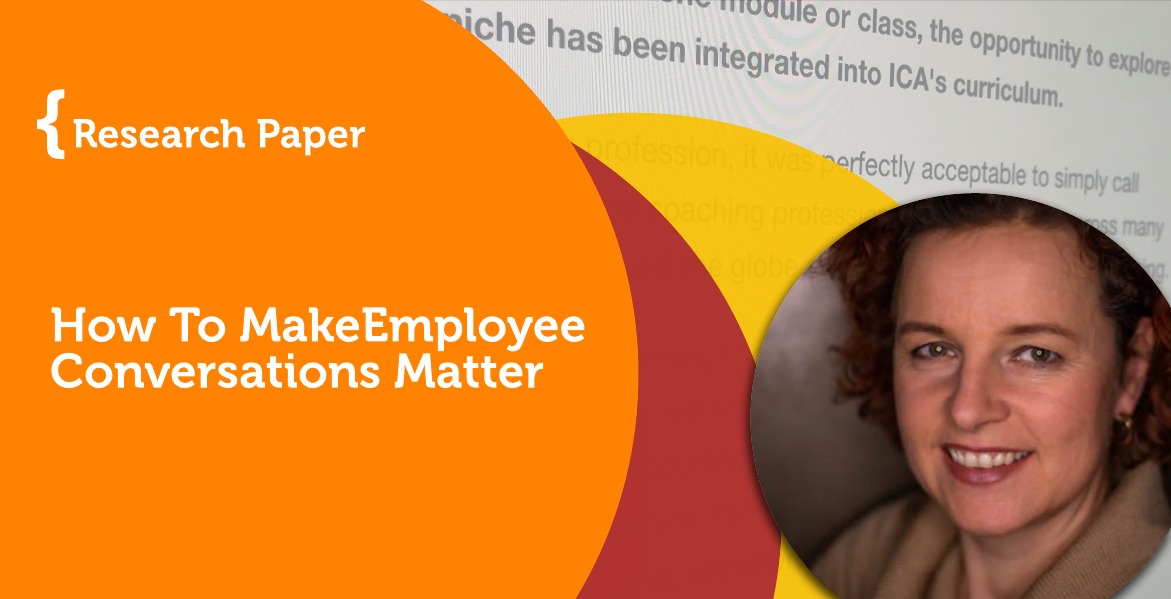
Research Paper By Petra Mayer-Dietrich
(Leadership Coach & Career Coach, SWITZERLAND)
Introduction
This research paper explores the importance of coaching in the interaction of team leaders and individual team members today and why it continues to be important in the future. It provides a short, practical guide for team leaders on how to integrate coaching in the 1-2-1 session with their employees. The examples used in this paper are either own experiences or based on responses to a survey performed amongst corporate team leaders.
Particularly in a fast-paced world where everybody is very busy, there is a risk of individual sessions with employees and teams becoming predominantly deliverable focused versus addressing the individual employee needs. While coaching is important for all generations in the workforce, coaching continues to be specifically significant for the young generations starting their professional careers. According to the Harvard Business Review, “Millennials Want to Be Coached at Work”, the ‘young people in the office’ are described to crave — and respond to — a good, positive coach, who can make all the difference in their success. (Willyerd, 2015).
Such got confirmed recently. As part of a student mentoring program where I recently partnered with two economic students’ mentees, I asked them why they had chosen me as their mentor. Independently, both said that they selected me because of my engagement as a coach, besides the professional experience.
What is coaching?
Let’s remind ourselves how coaching is defined (International Coaching Federation Switzerland, 2020); I marked key words (blue) which you will see being referenced further along in this document:
“Coaching is partnering with clients in a thought-provoking and creative process that inspires them to maximize their personal and professional potential.
Coaching helps clients to define and take action toward the realization of their visions, goals or desires. Professional coaching uses a process of inquiry and personal discovery to build the client’s level of awareness and responsibility and provides the client with structure, support, and feedback. The coaching process helps clients both define and achieve professional and personal goals faster and with more ease than would be possible otherwise.
In each meeting, the client chooses the focus of conversation, while the coach listens and contributes observations and questions. This interaction creates clarity and moves the client into action. Coaching accelerates the client’s progress by providing greater focus and awareness of choice…”
Survey Coaching & Leadership
To enrich this research paper with insights from other corporate professionals, I conducted a survey on the topic of Coaching & Leadership. The survey targeted experienced leaders who are or have been leading teams in their professional, corporate careers. Below some of the key results[1]:
The survey confirmed the importance of coaching, with coaching being a personal and individual matter which is likely not to be effective if prescribed. One commentary particularly emphasized that some employees, in fact, are resistant to coaching; whether a company supports not even being relevant.
What matters is that a team leader understands the concept of coaching and has the ability to develop a personal, authentic yet also situational coaching leadership style.
Companies can indirectly support coaching by embracing learning and personal growth in their corporate culture. Identifying KPIs to measure how coaching is applied can help, yet it cannot be considered the break-through concept to make it work. It is the sum of many attributes that contribute to the overall impact. It all starts with each one of us, no matter where in the organizational hierarchy you are. Only if individual team leaders make coaching a priority in the interaction with the employees, the challenges mentioned can be mastered. “Lead by example – it all cascades as we imitate what we see happening”.[2]
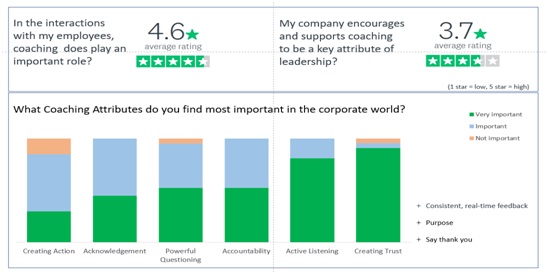
Coaching applied in 1-2-1 Employee / Team Leader Sessions
In the following part of this paper, I have combined core coaching tools, responses and practices shared in the survey with my own professional experience into a practical guide with Do’s and Don’ts as well as powerful questions (a fundamental skill of any coach!) for team leaders to consider in the dialogue with the employees.
In order to address multiple, different challenges I have broken down a typical 1-2-1 session into 4 steps. Each step carries its own aspect which a leader should be conscious about to allow coaching to be part of the interaction with the employee and to succeed in making the conversation with the employee really matter.
Coaching is not a one-off process, neither is it a process which follows one step after the other. At any point during the conversation, one may need to go back and revisit a prior point discussed. Just like every person is different, so is every coachee. As the survey confirmed, coaching is a very individual matter which rarely follows a strict process flow (as much as some of us would like that, it just isn’t).
Scheduling
The basis for every coaching session is that the time is well chosen to allow a focused, undisturbed conversation. A common feature in the corporate world is for a conversation to be tightly put in between two conference calls. While this cannot be avoided, it is important for the coach to ensure that the time setting does allow for a qualitative discussion. Nobody wants to be cut short on a personal point.
A coaching conversation to happen requires trust and being open to what comes up. Having the right setup and atmosphere is an important facilitator to achieve that. As we have seen in the survey and expressed in other valuable studies, building trust is an essential attribute for coaching to be successful. Trust is something that builds over time and hence each step, each interaction with the employee is a moment of truth on this journey. For this very reason, it is important for a leader to prepare for a session. How much time is required depends on the individual setup and how long the relationship has been in place.
The 7-Eyed Model(Hawkins & Robin, 2012) provides a structure which describes different ‘models’ impacting a coaching session one way or another. In preparing for a session, most critical in this context is the client (Step 1), the relationship client/coach (model 3), as well as the wider system (model 7). Specifically, the wider model is significant in the corporate setting. Considerations must be made from an organizational aspect (hierarchy, senior management, communication, key events or change initiatives) and personal aspects of the client’s life (family, health, values, other aspirations).
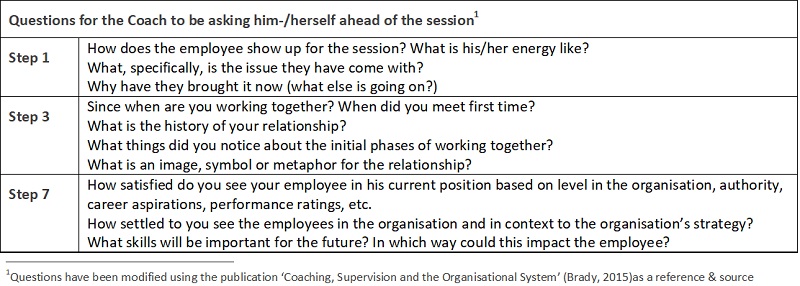
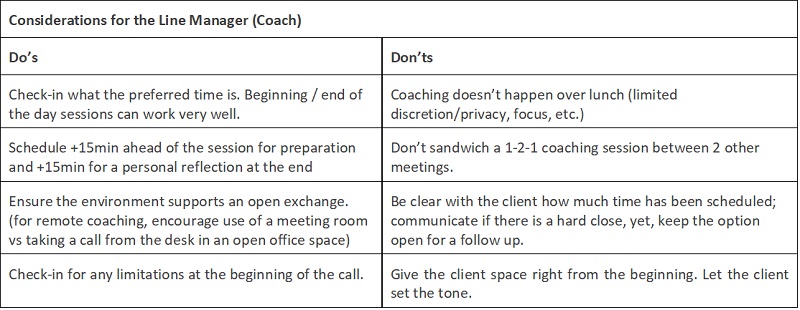
Set the objective
In Coaching terms, this is about ‘Setting the Agreement’. In a corporate environment, the objective most commonly is derived from performance measures that can be part of the conversation. During such a session, the line manager is looking to understand how the employee is doing against the performance measures. It is not uncommon for the manager to focus on the areas where set standards have not been met. Specifically, in hard times, when the sale is flat, prices at a low and customers dropping, the focus naturally shifts towards all the things not going well. It can put us on a mission to find the root cause, even when in conversation with the employees.
Yet, while this can be a typical starting point (not saying you cannot start there), a leader may want to consider starting a conversation with a blank page and to use the moment to address what is on the employees (coachee’s) mind. Also, there is also the option to start with what the client actually feels good about. What has happened recently that is worth acknowledging upfront? Later in the conversation with the employee areas where standards have not been met can be brought back into the conversation. The value of showing interest in the employee’s personal beliefs and values should not be underestimated. Particular in times where least expected.
Letting the employee lead the conversation bares a better opportunity to better understand personal views and motivations.
Below some questions the coach may want to consider at this stage:

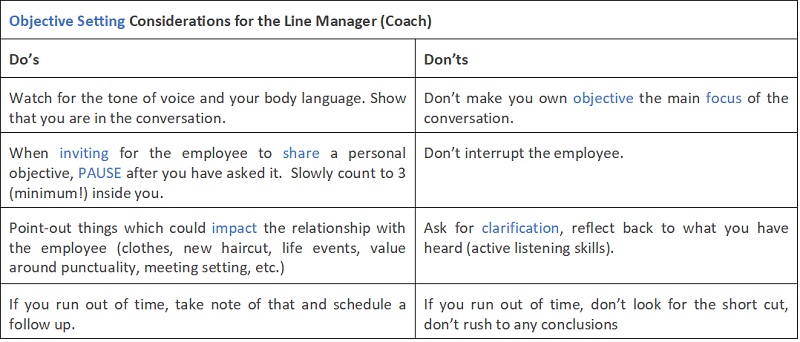
Conduct the session
During the session, it is important to stay with the employee. As in any coaching conversation, stick with the objective (the ‘agreement’). It is good practice to revisit the initial goal and to check progress or even if the objective has been accomplished, how satisfied the employee is in how the objective was reached.
Specifically, when not in space physical space and connected remotely, the leader must stay alert to the setting the employee is in (see Do’s under Scheduling). It is important that at any point no one is holding back because the setting doesn’t support the discretionary space required for an open conversation.
The employee should be doing most of the talking. Do gage who is taking up more air time – you as the leader or the employee. If you think it is you, you are most certainly right and talking too much. Try to step back. Focus on asking open-ended, powerful questions. 80% of the time the employee should talk, leaving you with 20%.
Let’s not forget though that there are employees who do talk a lot and you would easily get to the 80/20 distribution. Below you find also questions that you may use when such a situation arises *.
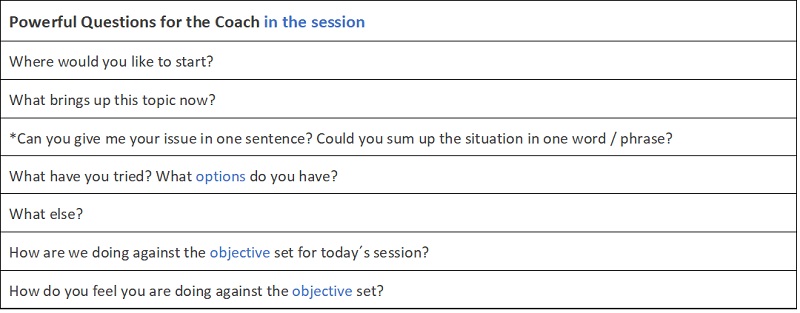
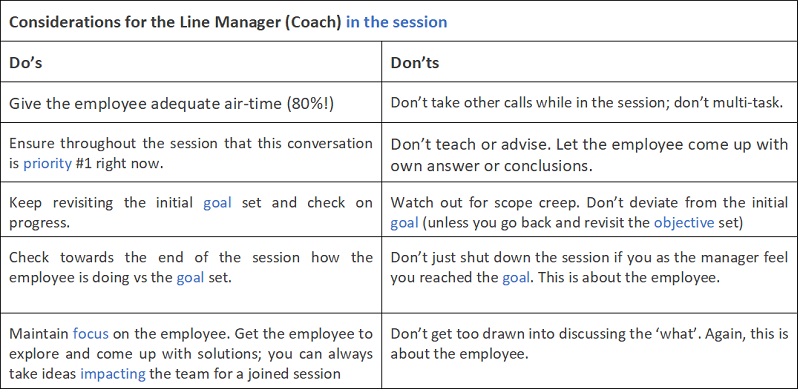
Decide on actions and follow up
In this final step don’t let time come in your way to close out a great conversation up to this point. There should be as much focus on the action on ‘what’s next’ as there has been the focus of the scheduling (step 1), the agreement (step 2) and conducting the session (step 3).
This is a crucial moment to build trust and at the same time sets the foundation for the next session. Do allow the employee to reflect on what was good about the session and what her/his personal takeaways are. In case you don’t get to that part and really have to wind down the conversation quickly, don’t forget to send a follow-up mail. Stay with the employee. Encourage the employee to write down the actions defined and any other learnings from the session. Only if the employee chooses to, those notes can be shared with you. Don’t make it a must, but a choice.
Also, be critical if you have made any commitments in the session of i.e. sharing information with the employee. Make sure you stick to what you said you would do and follow up in a timely manner. It is advisable to do so within the following 24 hours. There is no need to rush on this, leaving a night to digest, reflect is absolutely appropriate and in fact, supports to stretch out the positive reflection of a healthy conversation.

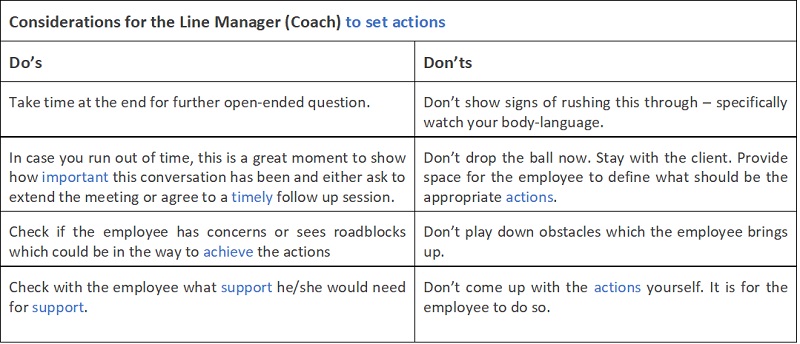
I hope you find this Research Paper practical. This has been the intention. Maybe you can pick up some useful thoughts that resonate with you. I would be very interested to hear back on that!
For me, it has been very inspiring to combine my learnings as part of the Certified Coach Program with the International Coaching Academy, my own +20 years professional experience working in international corporate organizations and using this opportunity to reach out to an incredible network & friends which I had the privilege to connect over the years.
Concluding with a quote from Timothy Gallwey (author and founder of the ‘The Inner Game’ coaching concept): “Coaching is unlocking a person’s potential to maximize their own performance. It is helping them to learn rather than teaching them.”
References
Brady, T. (2015). Coaching, Supervision and the Organisational System.
Hawkins, P., & Robin, S. (2012). Supervision in the Helping Professions. Open University Press.
International Coaching Federation Switzerland. (2020, February 04). Retrieved from www.coachingfederation.ch
Lally, P. (2009). How are habits formed: Modelling habit formation in the real world. European Journal of Social Psychology. Retrieved from
Palmer, W., & Crawford, J. (2013). Leadership Embodiment. In W. Palmer, & J. Crawford, Leadership Embodiment (p. 15). San Rafael.
Willyerd, K. (2015). Millennials Want to Be Coached at Work. Harvard Business Review. Retrieved from https://hbr.org/2015/02/millennials-want-to-be-coached-at-work
[1] Survey carried out in January 2020. Results may not be statistical representative, yet serves as a pulse and captures qualitative comments. In total, there have been 22 responses (out of 30 selected professionals invited to participate).
[2] Qualitative survey response to the question “What would it take for companies to embrace a coaching leadership style?”
[3] Questions have been modified using the publication ‘Coaching, Supervision and the Organisational System’ (Brady, 2015)as a reference & source